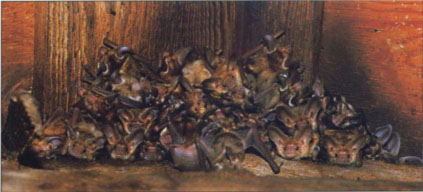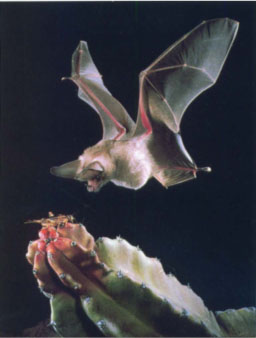All Issues
Bats can pack a punch in pest control
Publication Information
California Agriculture 52(1):6-7.
Published January 01, 1998
PDF | Citation | Permissions
Full text
Bats from a single colony can consume millions of insect pests each growing season and may someday play a key role in integrated pest management, if studies in the Sacramento Valley are any indication.
UC research has confirmed that Mexican free-tailed and Yuma myotis bats in the Sacramento Valley prey upon night-flying insects which include serious farm and urban pests — moths, beetles, flies, midges, mosquitoes and plant bugs ( see p. 8 ).
In the growing recognition that bats offer a natural and inexpensive means of pest control, hundreds of growers and homeowners state-wide are seeking advice on how to attract these mammals to their property, according to Rachael Long, UC field crops farm advisor in Yolo and Solano counties.
“In the last couple of years in the Sacramento Valley alone, I've advised at least 60 growers on how to build bat houses.” Long says. “There has been a great deal of interest in the ability of bats to control pests on high value crops, such as codling months which prey on orchards.”
Bronwyn Hogan, a graduate student at California State University, Sacramento, and coinvestigator with Long, notes “A typical colony of 150 bats will eat several million insects each season, according to research from Texas. And bats may also protect crops from pests by ‘chasing’ insects away with their echolocation calls.”
A number of moths, including cutworms, armyworms and bollworms are sensitive to bat echolocation up to 120 feet away, and turn away or dive to the ground when exposed to pulsed sounds, she says.
“In spite of their benefit to farms and the environment as whole, bats have been maligned and even today are subject to eradication campaigns. Little effort has been made to protect their roosting and foraging habitat,” says Hogan.
More than half of American bat species are in severe decline or are already listed as endangered, according to Merlin Tuttle, president of Bat Conservation International (BCI). In California, at least 10 of 24 species are designated “of special concern” by California Department of Fish and Game (CDFG), meaning their numbers are in decline and they require special management to preclude further losses.
Most bat eradication efforts are fueled by fear of bats themselves, often based on myths and legends. While bats, like all mammals, can contract rabies, less than a half of 1% of bats actually do, according to BCI. And rabid bats do not become aggressive — unlike cats and dogs. They bite only in self-defense, and pose little threat to people who do not handle them.
If a sick or injured bat is found on the ground, the finder should call a local wildlife care center or the California Bat Conservation Fund, Hogan said. No bat should be moved unless the handler is wearing thick protective gloves.
CDFG biologist Betsy Bolster says that bats, like all nongame mammals in California, are protected from hunting, collection and extermination — unless they cause property damage.
“In cases of property damage, we strongly recommend exclusion rather than extermination,” she says. “If you kill bats, it doesn't solve the problem. You kill bats, it doesn't solve the problem. You still have an accessible shelter that will attract them again.
“Bat exclusion involves using nets, plastic drapes or one-way tunnels which allow bats to leave but not to return.” Exclusion should be done before bats begin reproducing and raising their young, an activity which occurs between mid-April and mid-August. Alternatively, since many bats migrate in October, their entry points can be sealed after they depart.
While humans sometimes intentionally destroy bats, other bat declines are the indirect result of human activity. “Some bat declines are the result of land development. Many bat species roost in old, defective trees and feed near water sources. The loss of natural vegetation can have serious consequences for bats,” says Dixie Pierson, a wildlife biologist in Berkeley.
Because of the recent, increasing grower interest in the beneficial aspects of having bats as neighbors, it is critical for scientists to learn more about the role of bats in the agricultural ecosystem, says Hogan.
There are few data on the food habits of bats in California. Scientists need to assess the diet and forging behavior of bats on a local level, because food habits vary with locality, time of year, species of bat, time of feeding and available insect prey.
To begin answering these questions, Long and Hogan plan to investigate the effects of the two species of bats in an agricultural area of the Sacramento Valley.
The researchers will use “bat detectors” to perform acoustic surveys; detectors convert high-frequency bat calls, inaudible to human ears, to lower frequency, audible sounds. They will also tag bats with small glowsticks to gain a visual impression of where bats are foraging and in what manner. The tag, attached with tape or weak nontoxic glue, fall off within a few hours.
Bat feeding activity and insect pest species abundance will be surveyed in row crops, orchards, marshes, open grassland, urban and suburban areas around the roosts. Researchers will determine whether there is a relationship between bat foraging and the timing and density of insects. In other studies, Long and colleagues are studying natural bat roost characteristics to help design bat houses.
For general information about bats, contact BCI in Texas at www.bci@batcon.org or call (512) 327-9721. For more specific information about California bats or to report an injured bat or a colony, contact the California Bat Conservation Fund at forbats@batnet.com or call (415) 456-6598. You may also contact the Wildlife Management Division of California Fish and Game at (916) 654-3806.






